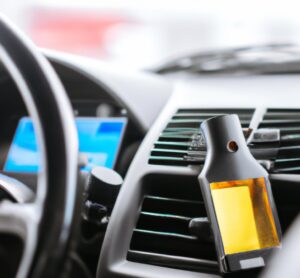
Drunk driving is a serious problem in the United States, resulting in thousands of deaths and injuries each year. To combat this issue, the National Transportation Safety Board (NTSB) has recommended that alcohol detection devices be installed in all new vehicles. The devices would prevent intoxicated drivers from operating their vehicles and could save countless lives.
What Are Alcohol Detection Devices?
Alcohol detection devices are technologies that measure a driver’s blood alcohol concentration (BAC) level. These devices can be either breath-based or touch-based. Breath-based devices require the driver to blow into a tube, which then measures the BAC level. Touch-based devices measure the BAC level through the driver’s skin, typically through the steering wheel or gear shift.

How Would Alcohol Detection Devices Be Implemented?
The NTSB recommends that all new vehicles be equipped with alcohol detection devices as standard equipment. This means that manufacturers would be required to install the devices in all new cars, trucks, and SUVs. The devices would be set to prevent the vehicle from starting if the driver’s BAC level is above the legal limit of 0.08 percent, as per Florida Statute 316.193.
The NTSB also recommends that alcohol detection devices be installed in the vehicles of individuals who have been convicted of driving under the influence (DUI) or driving while intoxicated (DWI). This would help to prevent repeat offenses and could potentially save lives.
 We’re here to serve you. Our phones are open 24 hours a day.
We’re here to serve you. Our phones are open 24 hours a day.
Why Are Alcohol Detection Devices Necessary?
Drunk driving is a major problem in the United States. According to the National Highway Traffic Safety Administration (NHTSA), 10,142 people were killed in alcohol-impaired crashes in 2019. That’s an average of one alcohol-related death every 52 minutes.
Alcohol detection devices could significantly reduce the number of alcohol-related fatalities and injuries on the road. According to the NTSB, if alcohol detection devices were installed in all new vehicles, more than 7,000 lives could be saved each year.
 We’re Florida’s top litigation team with over 75 years of combined experience
We’re Florida’s top litigation team with over 75 years of combined experience
What Are the Benefits of Alcohol Detection Devices?
Alcohol detection devices have several benefits. First, they prevent intoxicated individuals from operating their vehicles, which could save lives. Second, they make it more difficult for individuals with a history of DUI or DWI to repeat their offenses, which could reduce the number of drunk driving incidents overall. Finally, they provide peace of mind to those who have lost loved ones to drunk driving accidents.
 From the initial call to updates on your case status, we are here to get you answers.
From the initial call to updates on your case status, we are here to get you answers.
Are There Any Concerns About Alcohol Detection Devices?
Some individuals have expressed concerns about privacy and the reliability of alcohol detection devices. However, the NTSB has stated that the devices would only measure BAC levels and would not collect any personal data. In terms of reliability, the devices would be calibrated and tested to ensure accurate readings.
Another concern is the cost of implementing alcohol detection devices in all new vehicles. However, the NTSB has stated that the cost of the devices would likely decrease over time as the technology becomes more widely used.
Drive Sober or Get Pulled Over: The Importance of DUI Penalties and Prevention
DUI penalties and prevention play a significant role in reducing the number of drunk driving incidents on the road. In addition to the implementation of alcohol detection devices, many states have strict DUI laws that can result in hefty fines, license suspension, and even jail time for individuals convicted of drunk driving.
To prevent drunk driving, law enforcement agencies and advocacy groups also promote public awareness campaigns, safe driving programs, and ride-sharing services. By promoting education and awareness, and providing alternative transportation options, we can reduce the number of drunk driving incidents and keep our roads safe for everyone.
What are the Costs Associated With Implementing Alcohol Detection Devices?
The costs associated with implementing alcohol detection devices in all cars can vary depending on the technology and the type of device used. One of the main costs is the cost of the device itself, which can range from a few hundred to a few thousand dollars per vehicle, depending on the type and accuracy of the technology. Additionally, there may be installation costs associated with the device, which may require additional wiring or retrofitting of the car’s electronics.
There may also be ongoing maintenance and calibration costs associated with the device to ensure its accuracy and reliability over time. Finally, there may be additional costs associated with training law enforcement officers and other professionals on the use of the device and potential legal costs associated with enforcing the use of the device. Despite these costs, many experts believe that the benefits of implementing alcohol detection devices in all cars may outweigh the costs in terms of lives saved and reduced healthcare costs associated with alcohol-related accidents.
NTSB Recommends Alcohol Detection Devices in All Cars: Benefits, Costs, and DUI Prevention – FAQ
What is the driver alcohol detection system?
The driver alcohol detection system is an innovative piece of technology designed to measure a driver’s blood alcohol content (BAC) quickly and prevent the vehicle from starting if the BAC is above the legal limit. This system aims to drastically reduce incidents caused by alcohol impaired drivers.
How do alcohol detection systems work in vehicles?
Alcohol detection systems, such as the driver monitoring systems, function by either analyzing a driver’s breath or through touch sensors which measure BAC via the skin. These systems are calibrated to know the legal limits, ensuring alcohol impaired driving is significantly minimized.
Are there benefits to exploring alcohol monitoring technology for everyday vehicles?
Absolutely. By integrating and actively exploring alcohol monitoring technology in vehicles, we can anticipate a significant reduction in traffic fatalities associated with impaired driving. This technology will not only deter individuals from attempting to drive under the influence but will also physically prevent a drunk driver from starting their vehicle.
What’s the NTSB’s stance on impaired driving crashes?
The National Transportation Safety Board (NTSB) is strongly advocating for the implementation of alcohol monitoring systems in all vehicles. They believe that by doing so, it will drastically reduce the number of impaired driving crashes, making roads safer for everyone.
How effective are driver monitoring systems in detecting an impaired driver?
Driver monitoring systems are designed with high precision and accuracy. They are intended to detect even small amounts of alcohol in a driver’s system, ensuring that an impaired driver does not get the chance to operate a vehicle.
Are there any other technologies in place to prevent impaired driving besides alcohol detection systems?
Yes, the NTSB is constantly looking to explore alcohol monitoring technology further and develop other impaired driving prevention technology solutions. While alcohol detection remains a primary focus, other technologies, such as driver fatigue detection and speeding related crashes deterrent systems, are also being investigated.
How do alcohol monitoring systems compare to traditional methods of detecting drunk drivers?
Traditional methods, such as sobriety checkpoints, rely on manual intervention and catching a drunk driver in the act. In contrast, alcohol monitoring systems are proactive, preventing the vehicle from even starting if the driver is over the legal limit. This ensures a much higher rate of prevention compared to post-facto interventions.

